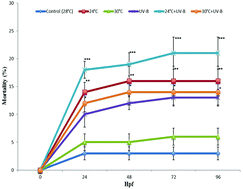当前位置:
X-MOL 学术
›
Photochem. Photobiol. Sci.
›
论文详情
Our official English website, www.x-mol.net, welcomes your
feedback! (Note: you will need to create a separate account there.)
The impact of ultraviolet B (UV-B) radiation in combination with different temperatures in the early life stage of zebrafish (Danio rerio)
Photochemical & Photobiological Sciences ( IF 2.7 ) Pub Date : 2017-11-02 00:00:00 , DOI: 10.1039/c7pp00236j Feyza Icoglu Aksakal 1, 2, 3, 4, 5 , Abdulkadir Ciltas 1, 2, 3, 4, 5
Photochemical & Photobiological Sciences ( IF 2.7 ) Pub Date : 2017-11-02 00:00:00 , DOI: 10.1039/c7pp00236j Feyza Icoglu Aksakal 1, 2, 3, 4, 5 , Abdulkadir Ciltas 1, 2, 3, 4, 5
Affiliation

|
Ultraviolet B (UV-B) radiation is an environmental stressor with detrimental effects on many aquatic organisms including fish. In addition, UV-B exposure combined with other environmental factors could have even more negative effects. The purpose of this study was to investigate the effect of UV-B radiation exposure on zebrafish embryos/larvae in terms of survival, developmental toxicity and the mRNA levels of the genes related to oxidative stress and innate immune response at different temperatures (24 °C, 28 °C and 30 °C). Zebrafish embryos were exposed to 3.3 W m−2 UV-B radiation and/or 24 °C, 28 °C (for the control) and 30 °C temperatures between 4 and 96 h post-fertilization. The mortality, hatching rate, malformations and heartbeat rate were evaluated. The results demonstrated that UV-B exposure or different temperatures (24 °C and 30 °C) induced developmental toxicity, including delayed hatching, increased the occurrence of malformations, and reduced the heartbeat rate and survival. The combined exposure to UV-B and different temperatures (24 °C and 30 °C) resulted in greater adverse effects on embryonic development. Furthermore, RT-PCR results showed that the mRNA levels of superoxide dismutase 1 (sod1), catalase 1 (cat1), heat shock protein 70 (hsp70), interleukin-1 beta (il-1β) and tumor necrosis factor alpha (tnfα) genes were significantly up-regulated in all of the treatment groups. These results revealed that the interaction between UV-B and temperature impaired the development of zebrafish embryos and disrupted their metabolism.
中文翻译:

斑马鱼(Danio rerio)生命早期阶段紫外线B(UV-B)辐射与不同温度结合的影响
紫外线B(UV-B)辐射是一种环境压力源,会对包括鱼类在内的许多水生生物产生有害影响。此外,UV-B暴露与其他环境因素的结合可能会带来更多负面影响。这项研究的目的是研究在不同温度(24°C)下紫外线-B辐射对斑马鱼胚胎/幼虫的存活,发育毒性以及与氧化应激和先天免疫反应相关的基因的mRNA水平的影响。 ,28°C和30°C)。斑马鱼胚胎暴露于3.3 W m -2UV-B辐射和/或受精后4至96小时之间的24°C,28°C(用于对照)和30°C温度。评估死亡率,孵化率,畸形和心跳率。结果表明,UV-B暴露或不同的温度(24°C和30°C)会诱导发育毒性,包括延迟孵化,增加畸形的发生并降低心跳率和存活率。暴露于UV-B和不同温度(24°C和30°C)的组合对胚胎发育产生更大的不利影响。此外,RT-PCR结果显示,超氧化物歧化酶1(sod1),过氧化氢酶1(cat1),热休克蛋白70(hsp70),白细胞介素1β(il-1β)的mRNA水平。)和肿瘤坏死因子α(tnfα)基因在所有治疗组中均显着上调。这些结果表明,UV-B与温度之间的相互作用损害了斑马鱼胚胎的发育并破坏了它们的代谢。
更新日期:2017-11-17
中文翻译:

斑马鱼(Danio rerio)生命早期阶段紫外线B(UV-B)辐射与不同温度结合的影响
紫外线B(UV-B)辐射是一种环境压力源,会对包括鱼类在内的许多水生生物产生有害影响。此外,UV-B暴露与其他环境因素的结合可能会带来更多负面影响。这项研究的目的是研究在不同温度(24°C)下紫外线-B辐射对斑马鱼胚胎/幼虫的存活,发育毒性以及与氧化应激和先天免疫反应相关的基因的mRNA水平的影响。 ,28°C和30°C)。斑马鱼胚胎暴露于3.3 W m -2UV-B辐射和/或受精后4至96小时之间的24°C,28°C(用于对照)和30°C温度。评估死亡率,孵化率,畸形和心跳率。结果表明,UV-B暴露或不同的温度(24°C和30°C)会诱导发育毒性,包括延迟孵化,增加畸形的发生并降低心跳率和存活率。暴露于UV-B和不同温度(24°C和30°C)的组合对胚胎发育产生更大的不利影响。此外,RT-PCR结果显示,超氧化物歧化酶1(sod1),过氧化氢酶1(cat1),热休克蛋白70(hsp70),白细胞介素1β(il-1β)的mRNA水平。)和肿瘤坏死因子α(tnfα)基因在所有治疗组中均显着上调。这些结果表明,UV-B与温度之间的相互作用损害了斑马鱼胚胎的发育并破坏了它们的代谢。











































 京公网安备 11010802027423号
京公网安备 11010802027423号